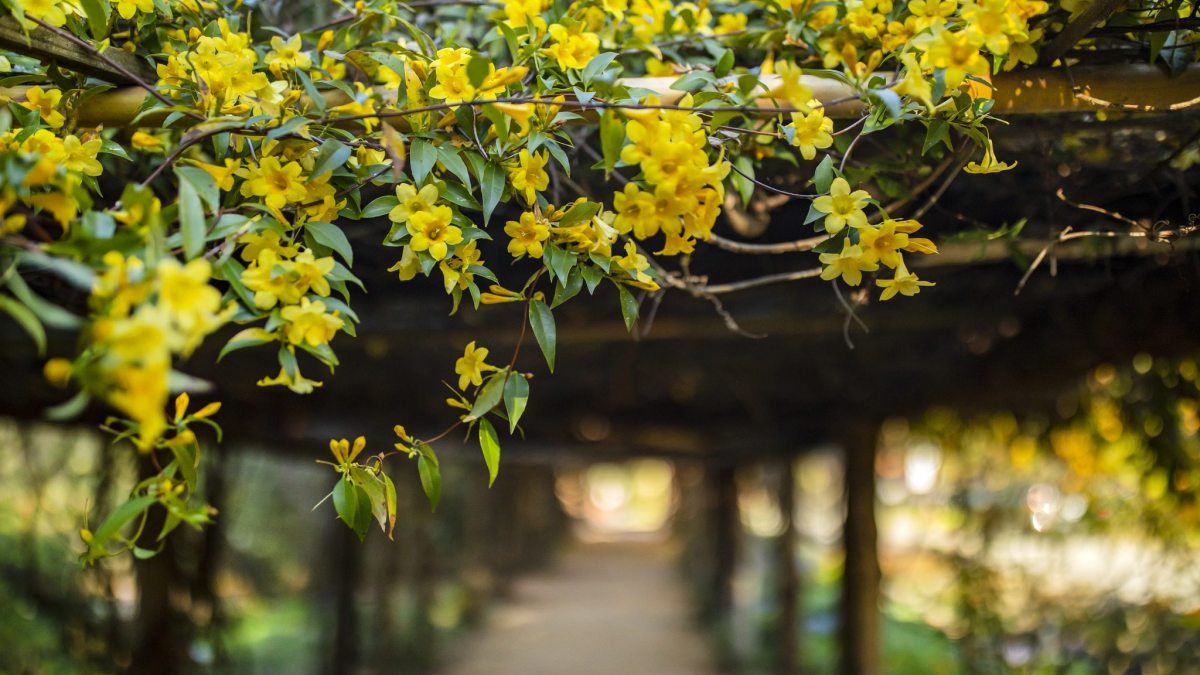Coker arbor renovation in progress
The yearlong project prioritizes legacy, safety and accessibility at the iconic campus landmark.

You may have noticed that the arbor at the Coker Arboretum is looking bare. In October, the process of removing the vines from the 300-foot-long rustic wood structure began as the first step in a renovation project for this beloved campus icon. Crews are expected to deconstruct the arbor during winter break.
Two main issues led to the renovation. The arbor’s stewards at the North Carolina Botanical Garden noticed some of the black locust timbers are deteriorating. In addition, the arbor walkway ends at a flight of stairs which makes the space inaccessible to many community members.
“Renovating the arbor and incorporating the beloved familiar elements with more long-lasting components will give the arbor a fresh, but familiar, look that will provide this iconic space longevity,” said Margo MacIntyre, curator for the Coker Arboretum.
UNC Facilities Planning and Design and a team from the botanical garden have joined together to make the arbor safe, accessible and available for enjoyment for years to come. The team is sharing project updates on the Coker arbor renovation webpage.
New arbor
The planning process has centered around maintaining the defining features of the arbor, which has undergone periodic renewal and renovation in its 100-plus-year history, and keeping in mind goals that preserve the value of the arbor to the Carolina community.
“We will honor the history of this campus landmark by retaining design elements that are essential to the arbor’s character and the experience of passing beneath it,” said Dan Stern, director of horticulture for the botanical garden. “Namely, the use of rustic materials, their rhythmic spacing and the interplay of shadow and light at a scale that retains the intimate feeling that people have come to associate with walking through the arbor.”

Coker arbor renovation concept design. (Courtesy of North Carolina Botanical Garden.)
Key goals and considerations for the new arbor aim to ensure that:
- The arbor is both a part of campus circulation and a place unto itself.
- The arbor provides a sense of welcome and orientation for the arboretum.
- The arbor supports education and the interpretation of native vines.
- The arbor is iconic as an experience and as a place.
- The character and scale of the landscape around the arbor enhances the experience of walking through the arbor.
- The interplay of structure and vegetation create a powerful experience of light and shadow,
texture and color. - The arbor provides moments of surprise and wonderment.
- The arbor is welcoming and safe.
The new walkway will have a slope roughly parallel with the street on Cameron Avenue. In addition to offering better accessibility, this will mean greater visibility and sightlines for public safety and enjoyment of other spaces in the arboretum.
The planning also includes consideration for a new vine collection. The botanical garden and arboretum team will work to decide what kinds of vines should be planted for the various sections of the arbor structure. The replanting of the vines is expected to happen in late fall or winter next year once the structure is completed.
History
In 1903, William Chambers Coker, the University’s first botany professor and first chair of the University Buildings and Grounds Committee, began developing a 5-acre plot of livestock-grazing land into an opportunity for students to study Asian and native trees and shrubs.
The original arbor, which sits at the south end of the arboretum, was donated in 1911 and built of black locust logs supporting Carolina jessamine and American, Japanese and Chinese wisteria vines. The arbor was reconstructed in 1974, and again in 1998 thanks to a gift from the Class of 1997 after the 1974 version succumbed to rot and damage from Hurricane Fran.
Tentative project timeline
November 2022: Complete removal of vegetation from existing arbor.
Mid-late December 2022: Walkway closed for demolition of arbor.
Early January 2023: Walkway reopens.
August-September 2023: Walkway closed again for construction: grading, pouring footings, constructing retaining walls, resurfacing.
October – November 2023: Construction of new arbor.
December 2023: Replanting vine collection.




